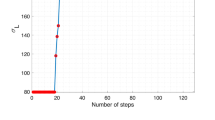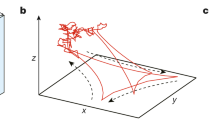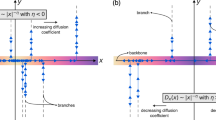Abstract
Questions often arise in the applied sciences concerning the transport of material through a system1–4 (for example, a chemical plant, the cardiovascular system or a river basin). Conserved particles such as molecules, blood corpuscles or colloidal particles passing through the system spend different times in the system even when the flow is steady. The theory of residence times1,2 may be used to relate tracer studies to theoretical or empirical models. Existing theory mainly concerns complete systems, but a few results have been established2,5–7 concerning the times that particles spend in a specific region (for example, a particular phase in a chemical reactor, an organ or a backwater) while passing through the system. I show here that the distribution of these ‘region residence times’ may be calculated from a system model by using a formalism in which the volumes of all the other regions are reduced to zero, allowing the region distribution to be calculated by well-established methods1,2 that apply to systems.
This is a preview of subscription content, access via your institution
Access options
Subscribe to this journal
Receive 51 print issues and online access
$199.00 per year
only $3.90 per issue
Buy this article
- Purchase on Springer Link
- Instant access to full article PDF
Prices may be subject to local taxes which are calculated during checkout
Similar content being viewed by others
References
Wen, C. Y. & Fan, L. T. Models for Flow Systems and Chemical Reactors (Dekker, New York, 1975).
Nauman, E. B. & Buffham, B. A. Mixing in Continuous Flow Systems (Wiley, New York, 1983).
Shepherd, C. W. Basic Principles of the Tracer Method (Wiley, New York, 1962).
Fischer, H. B., List, E. J., Koh, R. C. Y., Imberger, J. & Brooks, N. H. Mixing in Inland and Coastal Waters (Academic, New York, 1979).
Gibilaro, L. G. Chem. Engng Sci. 34, 697–702 (1979).
Nauman, E. B. Chem. Engng Sci. 36, 957–966 (1981).
Buffham, B. A. Nature 274, 879–880 (1978).
Rubinovitch, M. & Mann, U. A.I.Ch.E. Jl 29, 658–662 (1983).
Gibilaro, L. G. Chem. Engng Sci. 26, 299–304 (1971).
Roemer, M. H. & Durbin, L. D. Ind. Engng Chem. Fundamentals 6, 120–129 (1967).
Haddad, A. H. & Wolf, D. Can. J. chem. Engng 45, 100–104 (1967).
Mecklenburgh, J. C. & Hartland, S. The Theory of Backmixing (Wiley, Chichester, 1975).
Author information
Authors and Affiliations
Rights and permissions
About this article
Cite this article
Buffham, B. Residence-time distributions in regions of steady-flow systems. Nature 314, 606–608 (1985). https://doi.org/10.1038/314606a0
Received:
Accepted:
Issue Date:
DOI: https://doi.org/10.1038/314606a0
This article is cited by
Comments
By submitting a comment you agree to abide by our Terms and Community Guidelines. If you find something abusive or that does not comply with our terms or guidelines please flag it as inappropriate.



